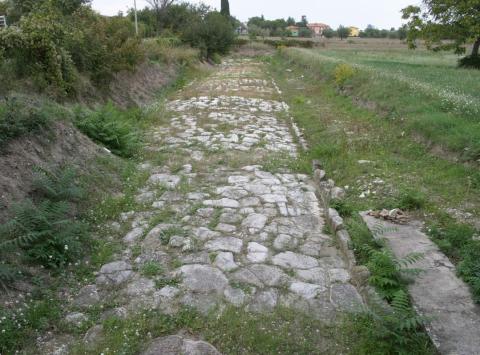The Via Flaminia was fundamental for the connections between Rome, Cisalpine Gaul and all northern Europe.
So the cities that presented themselves as main junctions of this route knew a happy prosperity: from Rimini to Pesaro up to Fano, then towards Rome until you meet the incredible bottleneck of the Furlo Gorge, an extraordinary canyon between the mountains Pietralata and Paganuccio, and then continue until you reach the capital of the empire.
Who today follows the ancient route of the Via Flaminia, will meet archaeological sites of great importance, towns surrounded by walls and perched on the hills of the Metauro valley, suggestive natural scenery: miles and miles of small wonders to discover without haste.
History
The road that connects the Adriatic coast with the Tyrrhenian has a "father": the Roman consul Caio Flaminio. Thousands of slaves were employed to carry out the ambitious work, and the consul’s legions also engaged in the difficult construction.
The Tunnel
Furlo has four galleries, each of which represents a milestone in the history of Italian road network.
The first Umbrian-Etruscan tunnel was built in 400 B.C. and it responded to the need to develop commercial relations. This tunnel measured 8 meters in length, 3.30 in width and 4.40 in height. The technique used for its construction involved a heating of the rock and then an immediate cooling of the same with water and vinegar, to go then to work with a chisel and remove the chipped material. It probably took a couple of years for the tunnel to be completed, but the effects were immediately evident: finally the gorge could be crossed even when the waters of the Candigliano river were in full.
The road soon became a European road and the Romans equipped it with road construction works, such as viaducts and support walls, in the most critical points. Near the Abbey of Petra Petrusa is preserved a viaduct of excellent workmanship and, in the Furlo Gorge, are still visible admirable wall works supporting the road. Later, it was an emperor who took care of the works of improvement of the Flaminia: Vespasiano, from 70 to 76 AD, did in fact work for the opening of a gallery that made it easier to overcome the gorge.
Later, the emperor Vespasian, mindful of the difficulties encountered by his army in crossing the Furlo, decided to make the passage easier by digging a new tunnel. Work on its construction lasted six years and thousands of slaves were engaged in the enterprise. At the end, the tunnel had respectable dimensions: 38.30 meters long, 5.40 meters wide and 4.80 meters high.
In the 1980s, ANAS implemented a project to adapt the Flaminia to two parallel unidirectional galleries. The first was opened to traffic in 1985, the second in 1991.
The fate of the Flaminia was marked by more or less long periods of interruption of transit caused by the boulders that, falling from the walls of Pietralata, obstructed the passage.
Today the Via Flaminia, in addition to maintaining the role of an important road, allows the visitor to take a fascinating itinerary.
The path
The Via Flaminia is an authentic open-air museum: bridges, galleries, memorial stones, inscriptions, archaeological sites, sewerage systems, etc.
It starts from Fanum Fortunae (Fanum Fortunae) which, with its Arch of Augustus (9-10 AD), is certainly one of the cities along the ancient consular road that best preserves its Roman remains.
In Tavernelle di Serrungarina were found objects such as pottery, amphorae, coins and a rare marble head of Attis, objects that seem to indicate the existence of an ancient station. You can see, always in Tavernelle, the remains of a sacred shrine, and then reach, in the municipality of Fossombrone, the town of San Martino del Piano where you can see the archaeological area of the ancient Forum Sempronii. Not far away are also the remains of a domus with spa. To visit the Archaeological Museum of the Corte Alta, where many finds from this area are preserved.
Not far away is the town of Calmazzo, where a Roman burial enclosure with two memorial stones recalls the Cissonia family.
From Calmazzo you can reach the suggestive Gola del Furlo, with the Vespasiano tunnel (76 AD) that you can still drive.
After the Gorge, you reach the town of Acqualagna where, near the ancient abbey of San Vincenzo, there is the Roman viaduct built in the Republican era with Furlo stone, which was intended to repair the Flaminia road from the floods of the Candigliano stream.
In Cagli (the ancient Cale) remains the Mallio Bridge, built at the end of the Republican era and once destined to cross the Bosso stream. Two more Roman bridges in the municipality of Cantiano: in Pontericcioli, along a path that deviates from the current route of the road, emerge numerous Roman structures and the so-called Ponte Grosso, of Augustan age, with two arches separated by a breakwater. A second monumental Ponte Grosso still allows the Via Flaminia to cross the Burano River, through two arches about 7 meters wide, with central pylon and breakwater.
